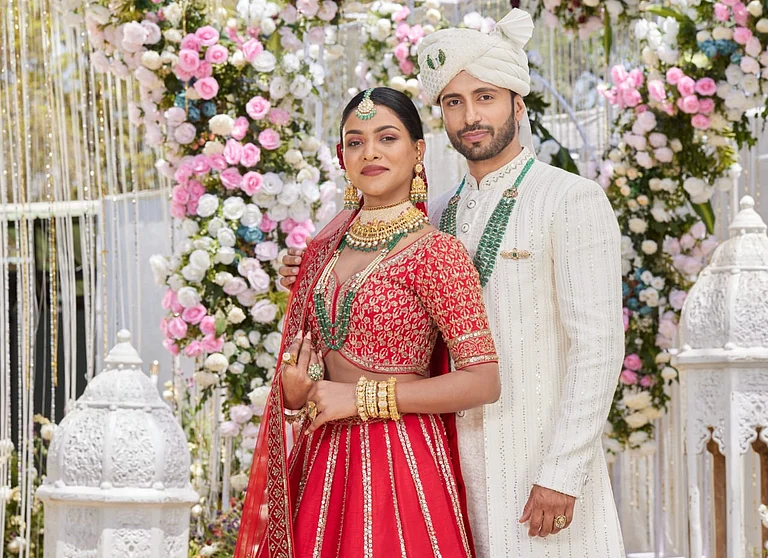As the doors of Trippy Tequila opened, it was pitch dark at first, then suddenly blinding as you walked a few steps ahead. The hit ‘90s song ‘Joru Ka Gulam’ blasted at full volume, with the dhol walas synced to the tune of the music played by the DJ, and (fake) 500-rupee notes rained on the decked-up guests as they did their thumkas.
People had paid at least Rs 1,000 as an entry fee to participate in this event at the gastropub located in Gardens Galleria Mall, Noida. ‘Fake Wedding’ has recently become popularised over social media, with clips of people wearing ethnic attire dancing to shaadi hits. What exactly is this trend? It is essentially people attending an organised party (read paid event) that mimics the essence of a big fat Indian wedding with music, food, songs, and attire, but without a groom and a bride.
Four long tables, lined with chairs on both sides, stood as if awaiting guests for a langar, bhog, or sadhya, some auspicious ceremony. Yet, we were in a club, with neon waves of colour radiating from the stage, casting a glow that felt unfamiliar. With faces turned towards the dance floor, the guests sitting were wearing lehengas, shararas, and sarees. However, many men did not adhere to the dress code that was boldly mentioned on the BookMyShow invite: ‘Wear Traditional Attire And Get A Complimentary Shaadi Wali LIIT.’
It was no less than attending the Ambani wedding, as one would bump into the press at all points of time, and lots of influencers were making content. The guests who had come might think it was so they could enjoy an Indian wedding experience, much like Mark Zuckerberg and the Kardashian sisters, but the press and influencers knew they were there to witness another act of voyeurism for people to consume and another trend to engage in.
While sharing her experience attending the event, Ridhu, who just finished dancing to ‘Gallan Goodiya’ with her friend Gaurav, shared: “These days, we’re all living in our own nuclear worlds. Everyone is in their own zone. Now we curate things that we want to be part of in our world. You may want to be in your family’s or your relatives’ wedding, but you are unable to attend, or you don’t want to take that chance. This is the kind of space where you can take that chance, without that typical relative vibe."
Marriage as an institution has always had its issues, with more labour, both physical and emotional, being demanded of women. But the wedding itself as a concept historically has been a celebration of people getting together, be it through love or just the act of declaring oneness among clans, kingdoms and societies.
Ritum Umrao, a young attendee dressed in a sparkly Anarkali set paired with kitten heels, big bright earrings, and a half-updo, was one influencer among the plentiful in attendance.
When asked what she thought was so special about the event, she shared: “It reminded me of weddings in my village. You know that odd kind of been they play there? I heard it hear too—not exactly the been, but something like it. And that gave me a proper village wedding feel.” She then went on to state, “No matter how much people move to Delhi or Noida, they still belong to villages at heart.”
While Umrao was trying to find a connection to her roots and people, Rushika, an office-going employee who turned up with her “girl gang” after work, came to enjoy the vibe minus her relatives: “Weddings are usually dramatic because of all the family issues, the chaos, and over-involved uncles. But here, there’s no drama at all. So, you can just be free and do whatever you want.” It is not about Rushika vs. Umrao, but to understand that weddings have become a part of everyone’s cultural memory, and, good or bad, they hold a space in everyone’s collective consciousness, big enough for people to want to experience it, even momentarily, through crowded chaat counters, genda phool tied to railings inside the venue, or servers wearing sehra.
Both Rushika and Umrao, who got reeled in to attend the event through viral social media clips, despite their views, they agreed on one common thing: that the general dress code for regular clubs expects women to dress in short and revealing clothes, even if there’s not a strictly imposed one, there’s a looming expectation to dress ‘hot’. Umrao shared: “In clubs, everything is more open and revealing. But I like wearing this, ethnic, kind of outfit, so I was most excited about my suit, especially wearing it in a club setting.”
With urbanisation and a nuclear family setup, communal activities have declined, accompanied by the fast-paced nature of life today, leading to limited social interaction. Has this let late-stage capitalism sell us the idea that we can still enjoy a community without the strings attached? No family, no friends—you just come and get the good parts without the emotional messiness, which is actually a part and parcel of any kind of human interaction, be it friends, siblings, lovers, and so on.
“Whoever wants to do whatever they like can do so without being judged by relatives,” shared Gaurav, who was dressed in a black kurta, when asked what makes this viral trend of wedding-themed parties one that might sustain itself.
So, is this trend showing us a mirror to a future where people will socialise in simulation rather than having any deep-rooted attachments, or is this another harmless trend which will leave soon, once its shelf life is over, like all the other trends?
















